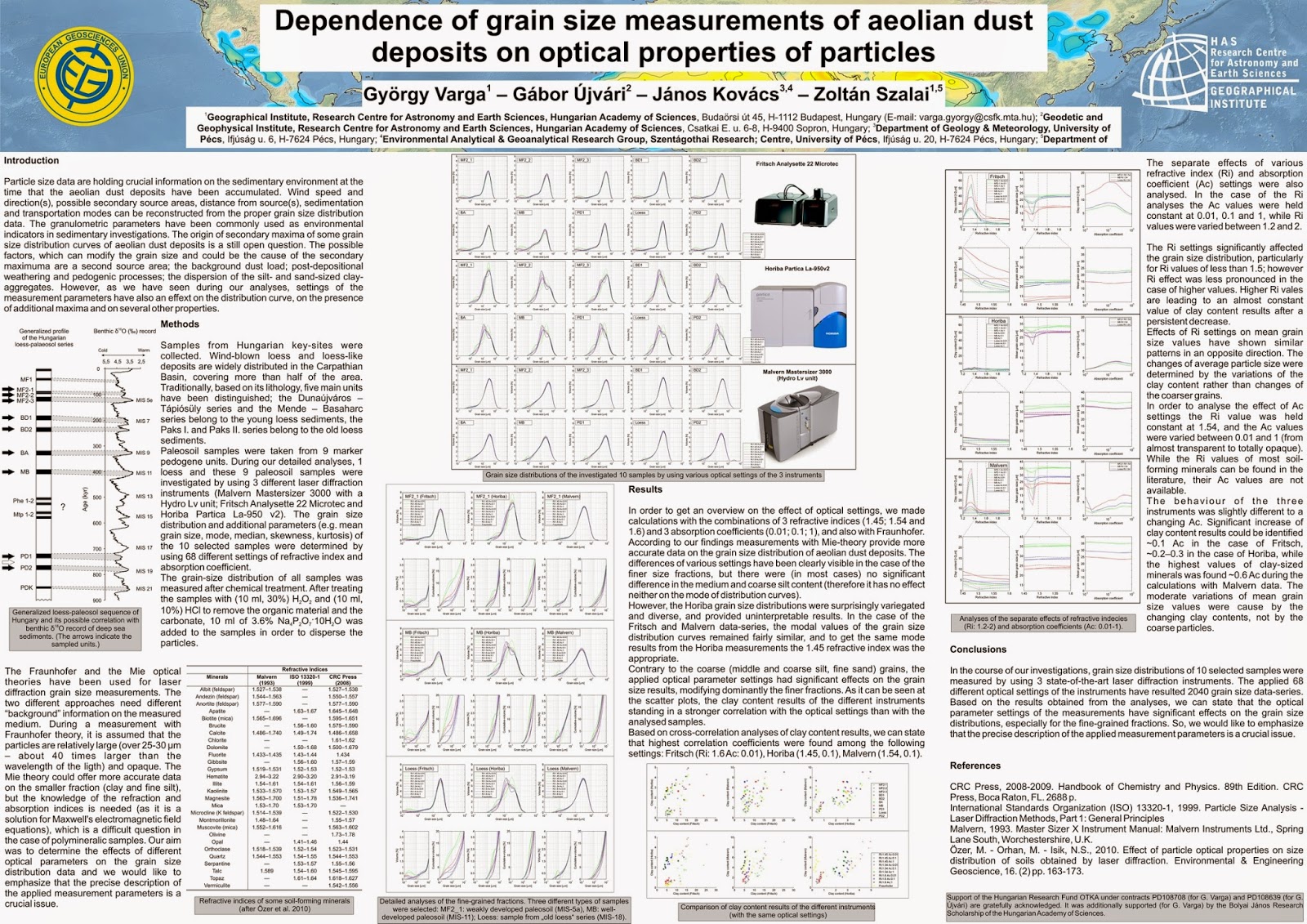Bécs, Ausztria
Időpont: 2015. április 12-17.
Helyszín: Austria Center Vienna
The EGU General Assembly 2015 was again a great success with 4,870 oral, 8,489 poster, and 705 PICO presentations. 577 unique scientific sessions together with 310 side events created an interesting programme. At the conference 11,837 scientists from 108 countries participated, of which 23% were students, 15,000 copies of EGU Today distributed, keen media presence and reporting, and thousands of visits to the webstreams as well as to the EGU blog GeoLog.
Effects of particle optical properties on grain size measurements of aeolian dust deposits
Particle size data are holding crucial information on the sedimentary environment at the time the aeolian dust deposits were accumulated. Various aspects of aeolian sedimentation (wind strength, distance to source(s), possible secondary source regions and modes of sedimentation and transport) can be reconstructed from proper grain size distribution data. Laser diffraction methods provide much more accurate and reliable information on the major granulometric properties of wind-blown sediments compared to the sieve and pipette methods.
The Fraunhofer and Mie scattering theories are generally used for laser diffraction grain size measurements. The two different approaches need different ‘background’ information on the medium measured. During measurements following the Fraunhofer theory, the basic assumption is that parcticles are relatively large (over 25-30 µm) and opaque. The Mie theory could offer more accurate data on smaller fractions (clay and fine silt), assuming that a proper, a’priori knowledge on refraction and absorption indices exists, which is rarely the case for polymineral samples. This study is aimed at determining the effects of different optical parameters on grain size distributions (e.g. clay-content, median, mode).
Multiple samples collected from Hungarian red clay and loess-paleosol records have been analysed using a Malvern Mastersizer 3000 laser diffraction particle sizer (with a Hydro LV unit). Additional grain size measurements have been made on a Fritsch Analysette 22 Microtec and a Horiba Partica La-950 v2 instrument to investigate possible effects of the used laser sources with different wavelengths. XRF and XRD measurements have also been undertaken to gain insight into the geochemical/mineralogical compositions of the samples studied.
Major findings include that measurements using the Mie theory provide more accurate data on the grain size distribution of aeolian dust deposits. Significant differences between the Mie and Fraunhofer approaches have been found for the finest grain size fractions, while only slight discrepancies were observed for the medium to coarse silt fractions. Since the two approaches gave similar results for the medium to coarse silt fractions that are the most abundant in loess, the use of the different approaches has no appreciable effect on the mode of the distributions. In conclusion, the two different applied optical parameter settings has had significant effects on the finer tail of the aeolian grain size distributions.
Support of the Hungarian Research Fund OTKA under contracts PD108708 (for G. Varga) and PD108639 (for G. Újvári) are gratefully acknowledged. It was additionally supported (for G. Varga) by the Bolyai János Research Scholarship of the Hungarian Academy of Sciences.
Various environments of interglacials recorded by Pleistocene paleosoils in Hungary (Central Europe)
Based on stable isotope analyses of worldwide reference curves from deep sea, ice core and speleothem records, it has long been apparent that duration, intensity and climatic conditions of different interglacial periods were significantly diverse. As a consequence of negligible fresh, detrital material admixture during interglacials, the soil formation intensity and maturity of various kinds of past soils have been holding vital information on the environmental conditions at the time the soils formed. This, in turn, means that several physical and chemical properties of soils allow us to reconstruct past climatic regimes.
Loess-paleosol sequences in Hungary (Central Europe) provide insight into the cyclic nature of glacial-interglacial variations of the last 1 million years. The paleosoils have been recognized as the product of warmer and moister interglacials, when the (glacial) loess material was altered by chemical weathering and pedogenic processes. 12 pedogene units from MIS-19 to MIS-5 strata were analysed in the course of this study, with a special attention to MIS-11 and MIS-19 periods, because of these can be regarded as analogues of the Holocene interglacial (due to the similarities in obliquity and eccentricity). Grain size, geochemical and (clay)mineralogical studies were elaborated and were gathered from previously published papers to quantify past weathering intensity and paleoenvironmental conditions by geochemical climofunctions.
The Upper and partly, the Middle Pleistocene loess deposits are intercalated by steppe, forest-steppe and brown forest soils, while the older pedogene horizons are different kinds; these are red, Mediterranean-type soils. The MIS-5 pedocomplex consist of three parts at several Hungarian sites, however the pedogene units cannot be correlated unequivocally with the three MIS-5 warmer substages, due to the scarce absolute age data. The MIS-7 and MIS-9 stages are represented by three forest steppe soils. The MIS-11 pedocomplex and MIS-17 and MIS-19 units are thick and well-developed forest soils, formed under a more humid climate compared to the younger pedogene strata. The geochemical data and climofunctions have been supported well these findings. Contrary to the global loess-paleosoil sequences, the MIS-13 and MIS-15 soils are not so dominant in the Hungarian series.
Support of the Hungarian Research Fund OTKA under contract PD108708 (for G. Varga) is gratefully acknowledged. It was additionally supported (for G. Varga) by the Bolyai János Research Scholarship of the Hungarian Academy of Sciences.





Nincsenek megjegyzések:
Megjegyzés küldése
Megjegyzés: Megjegyzéseket csak a blog tagjai írhatnak a blogba.